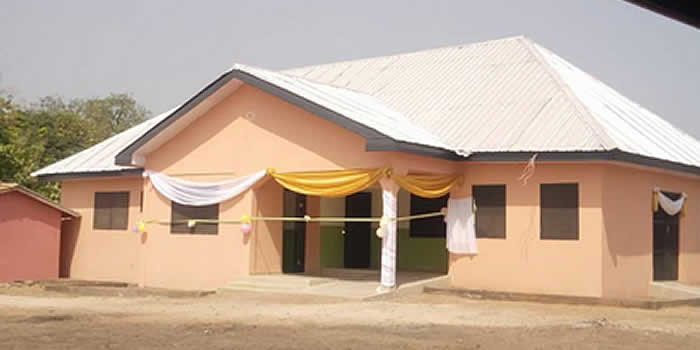

Location and Size
The District is located at the North Western corner of the Volta Region of Ghana and lies between Latitude 70 4” N and 8025’ N Longitude 00 25’ W and 00 20’ E. It is bounded to the South East by Krachi West, Krachi East Districts to the East, Sene East District to the South West and Kpandia District to the North. It has a total surface area of 2,969 sqkm and one hundred and ninety-six (196) settlements, with water covering about 15%. The major settlements include the following: Chinderi, Banda, Borae, Bejamse, and Akaniem. The District can therefore take advantage of its strategic location to attract investments from both Southern and Northern Ghana. Being strategically located in the transitional zone, the District’s closeness to the Brong-Ahafo and Northern Regions makes it a potential avenue for wealth creation through greater internal trade and positive socio-cultural exchanges between the districts in these regions.
Climate
The District has a tropical climate and has a mean maximum temperature of 300c usually recorded in March while mean minimum temperature of 25.50c is usually recorded in August. The District experiences alternating wet and dry seasons each year. The South-eastern part of the District experiences a double maxima rainfall. It occurs between May to June and October to November. The Northern portion, however, experiences single maxima over the period July to September which peaks in August. The mean annual rainfall for the District is 1,300mm. The dry season starts from November to March. Relative humidity is high in the rainy season, about (85%) and very low in the dry season (25%). The climate of the District is suitable for the growing of various crops such as yam, Shea butter etc. However, the influence of the long dry hamarttan has damaging effects on the environment and farm outputs.
Vegetation
The District lies in the Transitional Vegetation Savannah woodland Zone characterised by short scattered drought resistant trees that get burnt by bushfires or scorched by the sun during the long dry hamarttan season. Human interference with ecology is insignificant resulting in near semi-arid conditions. The most common economic fruit trees are the sheanut, dawadawa, and baobab. Fringing vegetation can also be found along the major rivers that drain the district. This vegetation type is however gradually being degraded because of overdependence on it for daily livelihood activities such as bush burning, charcoal burning, continues farming, overgrazing by cattle, as well as lumbering.
Relief and Drainage
The District is part of the North Western Savannah zone of the Volta region which is characterized by almost flat relief with slopes ranging between 85m and 300m above sea level. The district is endowed with a number of rivers and streams, the most important of which is the Dakar, the Volta Lake and OtiRiver which form the boundary between the District and the Krachi East District. Other water bodies found in the District include numerous intermittent streams located in most parts of the District. The relief and drainage systems favour the development of fish farming, cultivation of rice and dry season vegetables. These water bodies constitute important resources for the people as most of them depend on them for household use, fishing and transportation.
Soils and their Suitability for Agriculture
The major soils in the district include the Techiman Association (mainly sandy soils) in the north, the Kpelesawgu Association (sandy clay soils) in the mid-portions and the southern tip, the Dormanbin-Dentesso Association (silty sand) in the south and the Ejura-Amantim Association (sandy loam) in the west.
Minor soils groups include patches of Dadiekro Lima and Volta Lima Association (sandy loam) in some locations close to the Volta Lake. It was discovered that no soil management practices were undertaken. It is therefore not astounding that 70 per cent of farmers experienced loss in soil fertility in their farms. This is worsened by continuous cultivation, which exposed the soil to erosion.
Date Created : 11/29/2017 3:36:22 AM











 facebook
facebook
 twitter
twitter
 Youtube
Youtube
 +233 593 831 280
+233 593 831 280 0800 430 430
0800 430 430 GPS: GE-231-4383
GPS: GE-231-4383 info@ghanadistricts.com
info@ghanadistricts.com Box GP1044, Accra, Ghana
Box GP1044, Accra, Ghana